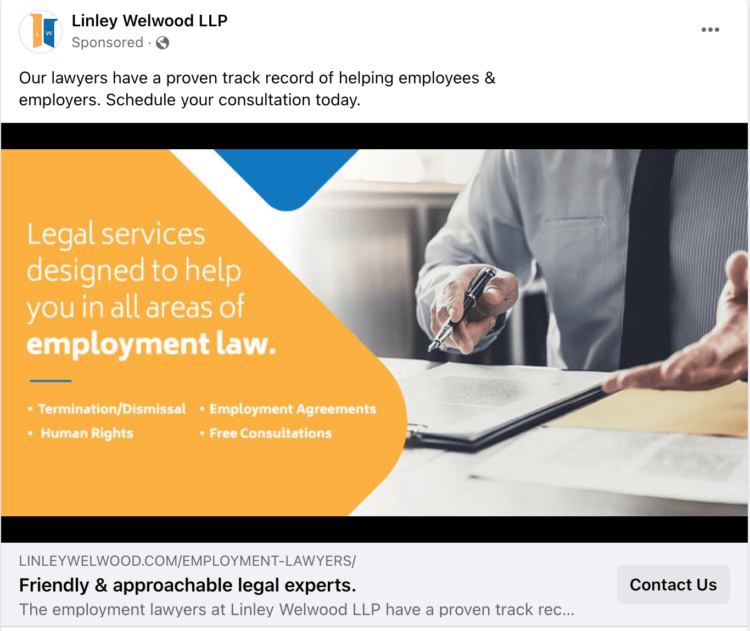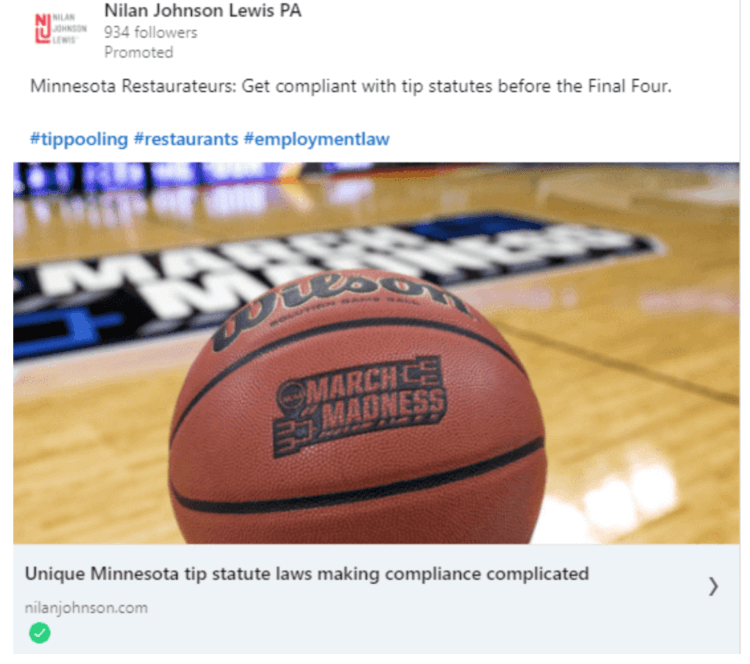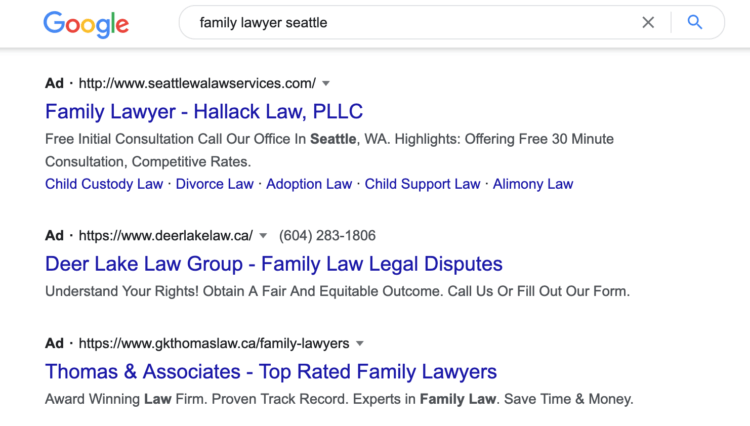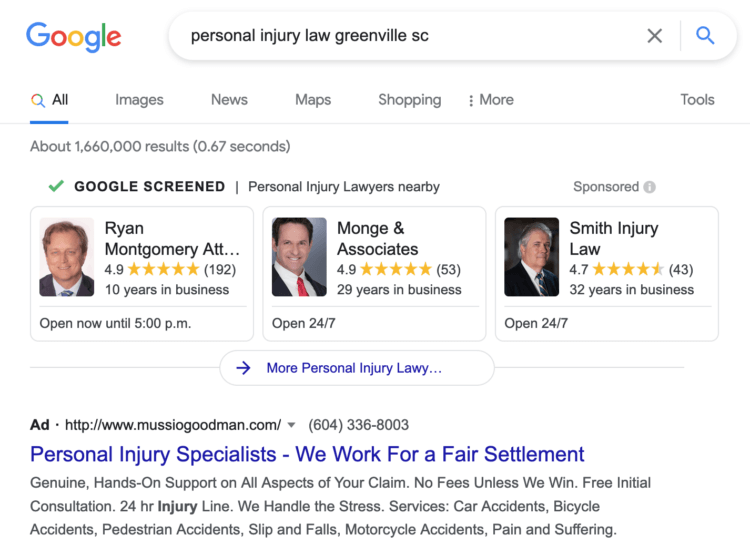Finding results-driven, cost-effective ways to increase brand awareness and convert new clients is essential for growth. This is especially true for law firms without substantial marketing or advertising budgets.
While many large firms with deep pockets opt for a diversified promotional mix of online, print, and traditional advertising (e.g., television, radio, billboard), small and medium firms may get better results by focusing on a digital approach to ensure the best return on investment (ROI).
Compared to offline advertising methods, digital advertising (e.g., pay-per-click campaigns, social media ads) is more cost-effective and flexible. Digital advertising also provides increased transparency for testing engagement and tracking relevant metrics. Even law firms with small budgets can create digital advertising campaigns that deliver strong engagement to drive lead generation and conversion.
Let’s take a look at the range of advertising channels available to law firms and examine the benefits of a digital strategy to increase awareness of your firm, drive new client acquisition, and boost the bottom line. We’ll also present some examples of law firm advertising for inspiration.
How to start advertising your law firm

Establish a law firm marketing strategy
Advertising is a valuable piece of a law firm’s overall marketing strategy. Make sure you’re clear on the role you want advertising to play in your promotional mix and how it aligns with your marketing goals. (If you’re still struggling to build a marketing strategy for your firm, here are 10 essential steps to help you craft a plan.)
Develop a law firm advertising budget
Budgeting is a crucial step towards creating an effective legal advertising campaign. But according to the ABA 2021 Tech Report, many small- and medium-sized law firms don’t have an annual marketing budget. The survey found that 55% of respondents from firms with 10-49 lawyers, and only 35% of smaller firms with 2-9 lawyers, had a marketing budget.
How large should your budget be? The short answer is, it depends. Every firm has different marketing goals and available capital. Think about small daily budgets for pay-per-click (PPC) and social media ads, as well as monthly or annual amounts for other advertising channels, such as print or radio ads. Consider setting aside 7-10% of your revenue for your advertising budget as a starting point.
Understand your target audience
Whether your firm specializes in criminal law, commercial litigation, or family law, your target audience has unique needs and wants. Your advertising should respond to those needs.
Start by defining the basic demographic and psychographic characteristics of your target market. Where are clients located? What stage of life are they in? What motivates prospective clients? What media platforms do they regularly engage with? Armed with this data, you’ll be able to focus ads to reach the audience most likely to convert to clients.
Have clear advertising goals
Setting advertising objectives is essential for monitoring progress and ROI to ensure you’re choosing the most effective advertising avenues for your law firm. Plus, setting goals will help you determine if you’ve allocated the right portion of the marketing budget to advertising efforts.
Be clear on what you’re trying to accomplish. Is your firm trying to increase its close rate? Or are you more interested in acquiring 25 new leads every month? Do you need to build brand awareness for your firm?
You can use these goals to guide your advertising strategy. For example, suppose the primary advertising goal of your small practice is to create brand awareness. In that case, your digital advertising campaign should focus on increasing impressions (digital views), reach and frequency, and driving customer engagement by tracking the click-through rate (CTR).
Test your law firm’s advertising efforts
Testing advertisements and their messages with a select audience before launching to the broader marketplace can help law firms benchmark their advertising activities. You can gather data on which ads are more (and less) successful, how different channels engaged with the ad, and what content audiences engaged with the most. Going forward, you’ll be able to hone your creative to optimize your advertising results.
Consider A/B testing (aka split testing) for comparing two versions of an ad to learn more about what convinces your target clients to convert. This technique is especially valuable and practical for digital advertising. A/B testing enables you to determine which words, tag lines, calls-to-action (CTA), images, videos, and other elements in your digital ad work best. Even seemingly insignificant characteristics like the text’s color or size can make a big difference in whether a prospect clicks your display ad.
Track your law firm’s advertising results
Regardless of which advertising vehicles you implement, don’t forget to measure your results. Key Performance Indicators (KPIs) help you evaluate your ROI and create improvement plans. Common KPIs for digital advertising platforms include exposure and reach (e.g., visits, views, subscribers), engagement (e.g., clicks, retweets, shares, comments), and actions or conversions (e.g., lead generation forms, content download, new clients).
What is the best type of advertising for lawyers?
Digital advertising is the most effective type of advertising for small and medium legal firms. Digital ads are targeted, cost-effective, and easily measurable. In addition, the digital approach provides flexibility across channels, invites mobile engagement, and is faster to market than traditional channels such as print or billboards.
Digital lawyer advertising campaigns
Digital ads are most effective when a complete campaign is built around them—with a relevant funnel for potential clients to click through. By building tailored landing pages and making sure all the touchpoints flow together, you can create a client-centered experience that drives conversion.
Lawyer advertising examples
You may like these posts
Social media advertising for lawyers
According to the ABA Tech Report 2021, 86% of surveyed firms had a presence on social media, including:
- 87% LinkedIn
- 61% Facebook
- 37% Twitter
- 13% Instagram
Law firms don’t need to advertise on all social media platforms; instead, pick the channels most relevant to your target clients. LinkedIn is an effective option if your target audience includes professionals or businesses. In fact, LinkedIn is the second most common marketing channel for lawyers (42% of firms in 2020) after event sponsorship.
LinkedIn advertising enables you to target your audience by location, industry, profession, job title/function, interests, and more to find prospects looking for the specific legal services your firm offers. With 40% of daily active users using LinkedIn daily, the platform is highly effective for corporate, tax, immigration, and other B2B legal practice areas.
LinkedIn offers Sponsored Content Ads (including video ads), Sponsored Messaging that sends personalized messages directly to the inbox of LinkedIn prospects who might be interested in your legal services, and text and dynamic ads that are displayed on the side of the main feed.
Facebook advertising—single image, carousel, or video ads—can be very effective if your firm’s area of practice is connected to life events or stages, such as or divorce or retirement. With Facebook’s highly-targeted ads, you can reach users who are more likely to need your services. For example, a wills and estates lawyer could target ads to new parents or newlyweds.
Social media advertising examples
Example 1: Facebook ad

This Facebook ad indicates that the firm specializes in employment law and provides examples of services offered. The “Contact US” CTA button makes it easy for prospects to connect with the firm. The choice of image is not inspiring, but the colors are bright and engaging and in line with the corporate color palette. Adding the firm’s location would make this Facebook ad even clearer.
Example 2: Facebook video ad

This Facebook ad includes a short video that communicates the attorneys’ reason for practicing and what differentiates their firm from competitors. The ad uses emotion and personalization to engage the viewer and the video voice over clearly outlines the services offered. The “Learn More” CTA makes it simple for prospective clients to connect with the law firm, while helping the firm track engagement for future ad planning.
Example 3: LinkedIn Ad

When the Final Four was held in Minneapolis, most downtown restaurants were booked up with parties. This LinkedIn ad by a Minnesota law firm targeted local restaurant decision-makers, alerting them to the state’s unique and complicated tip-pooling statute and urging them to comply before they faced a lawsuit (several suits were ongoing at the time).
Because the law firm defined their niche audience, the ad was shown only to those prospects who would be interested in this legal issue. By creating a sense of urgency for prospects, coupled with visual interest of the image of the basketball with the recognizable March Madness logo, this ad drove a 3.22% average CTR—well above the global average CTR of 0.44%-0.65% for sponsored content.
Search engine advertising for lawyers
Google Ads is a Pay-Per-Click (PPC) advertising system that enables you to create highly-targeted display ads that are shown to Google users fitting your target audience. Placing ads across the Google Display Network helps you find the right audience, with targeting options that strategically show your message to potential customers at the right place and the right time.
By targeting a hyper-specific audience, paid search ads can help law firms find new customers or engage existing customers using audience segments. Google Ads can also help drive more conversions using automated targeting and bidding to optimize the campaign. PPC ads can be a cost-effective advertising strategy: Google only charges you when a visitor clicks on your ad, and you can set daily spending limits.
You can also use Google’s Local Services Ads, which show up when someone in your area searches for your services. Unlike other Google Ads, you’re only charged for Local Services Ads when a potential client contacts you through the search result.
Please note that while Google Ads is the most common paid search advertising, you may decide to consider other search engines, such as Bing, if your target clients are regular users.
Search engine advertising examples
Example 1

These PPC ads for law firms in the Seattle area specializing in family law appeared during a Google search for “family lawyer seattle.” Hallack Law’s ad is effective because it clearly states what services/specialities they offer, their location, and a CTA of a free initial consultation—all the basics a prospective client is interested in.
Example 2

Available in select verticals in the U.S., Google Screened is a local service ads screening program that provides verification checks; potential clients have added peace of mind knowing that these professionals have been thoroughly vetted. Lawyers with the Google Screened badge have verified active law licenses.
Particularly effective for local targeting, Google Screened ads appear above PPC ads in search engine results pages, increasing the likelihood that potential clients may visit your website or contact your practice for services. In this example, Ryan Montgomery Attorneys at Law appears prominently in a search for personal injury lawyers in Greenville, SC. In addition, highlighting the 5-star rating in the ad lends credibility to the firm.
Local Services Ads
In short, Local Services Ads are pay-per-lead ads offered through Google that appear at the top of search engine results. They match prospective customers searching for a service with relevant businesses in the same area. The result? Customers get reliable suggestions, while companies see a better return on investment with more qualified leads.
Even better, with Google’s Local Services Ads for Clio, you can sign up for and manage a Local Services Ads account, set up and run ad campaigns, capture new leads, and measure campaign performance all within a single platform.
Here are some of the additional benefits:
- Build client trust: Earn a “Google Screened” badge verifying your business is qualified to offer legal services.
- Control your budget: Set your weekly budget and pause your ad at any time.
- Pay for results: Only pay when a potential lead contacts you through the ad, resulting in higher quality leads and cases. Plus, new Google Ads users will receive $500 in ad credits when they spend $500.
Learn more here, or book a live demonstration with a Clio expert.
Video marketing for lawyers
Video ads aren’t limited to TV commercials; YouTube and social media are great platforms for video ads that can serve as online billboards for your firm. Video advertising is a great way to convey complex legal concepts, engage with prospective clients, and prove you’re knowledgeable, trustworthy, and able to help.
Video advertising examples
While this series of classic adverts by New York-based personal injury law firm Trolman, Glaser, Corley & Lichtman originally appeared on TV, it demonstrates how humor can be used in video to create engagement and increase brand awareness.
To complement the Facebook ad campaign noted above, Jan Dils Attorneys at Law has created short 15-second video ads that can be delivered via social media or placed on the firm’s website to build awareness and drive conversion. These video ads are effective because they’re concise, personalized, and authentic.
Print advertising for law firms
While print advertising is showing signs of decline as consumers shift to consuming content online, some lawyers may find traditional offline advertising appropriate for reaching a specific audience.
Firms may choose to advertise in magazines, newspapers, or trade publications to build brand awareness and target local or niche prospective clients. Directory listings and direct mail strategies (e.g., brochures, flyers) are also useful options, depending on the target market.
TV and radio ads for law firms
Despite the digital transformation sweeping the globe, television advertising is not dead. If you have the budget, advertising on local television effectively boosts brand awareness and builds a law firm persona within your geographical target market. The caveat is that TV campaigns are expensive, especially for small and medium firms that may have modest marketing budgets.
While the perception is that many people are not in their cars commuting to work due to the pandemic, listening to the radio is still popular. Digital radio, in particular, is helping the industry get back to its pre-COVID ad revenue levels, according to December 2021 research. Industry analysts predict that total radio revenues will climb to $13.54 billion next year, up 5.9% from $12.79 billion in 2021, according to BIA Advisory Services Local Advertising Forecast 2022.
Although the cost may be prohibitive for smaller firms, radio advertising is ideal for targeting local and niche audiences who regularly tune into this medium. Keep in mind that frequency of ad placement is important for increasing your firm’s top-of-mind awareness. In addition to local radio, audio streaming services (e.g., Spotify, Sirius XM Radio) and podcasts are good advertising options for reaching niche prospects.
Law firm billboards
American drivers spend an average of more than 17,600 minutes behind the wheel each year. This fact might explain why billboards are a long-standing promotional medium for lawyers.
Billboard advertising may be more appropriate for firms with larger budgets. If you decide to pursue this option, keep in mind that advertising a specialty or a single type of legal service (e.g., personal injury or family law) is more effective than a one-size-fits-all marketing message.
(Wondering what NOT to do for your billboard advertising?)

The power of digital advertising
Digital advertising—whether you deploy video ads on Facebook, a PPC ad campaign using Google Ads, or small text ads displayed on the LinkedIn sidebar—has the flexibility, expediency, and impact to help your firm meet your advertising objectives and drive meaningful results.
While traditional, offline advertising channels may still be relevant for large law firms with sizable marketing budgets, small and medium firms can reap the rewards of an effective advertising campaign without the considerable cost of print, radio, tv, or billboards.
We published this blog post in January 2022. Last updated: .
Categorized in: Marketing







